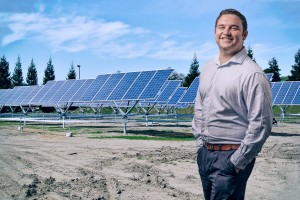Tracking Solar Technology Touches Down in the UK
Castillium links deal with QBotix, to offer projects that generate greater power and financial returns through patented robot technology
 A new US energy technology, which uses robotics to control solar photovoltaic (PV) panels and trackers to ensure they generate the maximum possible energy from sun rise to sun set, has arrived in the UK.
A new US energy technology, which uses robotics to control solar photovoltaic (PV) panels and trackers to ensure they generate the maximum possible energy from sun rise to sun set, has arrived in the UK.
Aimed at farmers and landowners who have 1 to 1.5 acres of land to site the solar panels, Castillium has brought the innovative Qbotix system to Britain for the first time after it has proved itself in other markets. https://www.youtube.com/watch?v=WRJX25n6_A4
According to Wasiq Bohkari, CEO of QBotix, “We are excited to work with Castillium for their projects in the UK. We think that they have a smart approach to building distributed generation solar power plants that brings value to their end customers in the farming industry. Our system is uniquely capable of optimizing financial benefit for installations at that scale.”
The new system uses the Robotic Tracking System (RTS), patented by California-based QBotix, to ensure the panels follow the sun each day like a sunflower. This accurate alignment, or optimized dual-axis tracking, means the system can capture the maximum energy from the sun all day.
On launching it into the UK this week Alistair Fell, a Director of Castillium said: “The QBotix system is more efficient than traditional static solar PV systems, offering customers better value for money than other solar PV equipment on the market.”
“Typically, the RTS system increases energy generation by 30-45% in the UK; improving return on investment by around 20% compared to static panels.”
This is a system aimed at farmers and landowners interested in generating on-site electricity. The QBotix system supplied by Castillium needs just 1.5 acres of land for the 20 plus year lifetime of the technology. At a maximum height of 3m, the system has a lower visual impact than a wind turbine and has fewer planning issues associated with factors such as noise, shadow flicker and radar, meaning it is easier to secure planning permission and less likely to cause problems with neighbours. Costs are marginally greater than static solar PV systems for the same system size, but the net costs for the same annual energy yield are less with QBotix and a typical 250kW installation offers a payback of 5 to 7 years.
Renewable energy is now an extension of the farmyard and an important potential source of income for farmers. The Castillium supplied RTS technology is both flexible and scalable and has limited barriers for on-farm power generation, ensuring that it can meet a farm’s entire electricity requirements. A 250kWp system will produce up to 320,000 kWh per year and an average farm uses only around 50,000 kWh a year. That makes the system a great source of energy for intensive farming with high electrical loads, such as dairy, poultry and pig units, grain drying, and any activity that needs cooling. Excess energy can be exported to the National Grid, creating an additional income stream.
The key benefits of this system from Castillium and QBotix include:
- Tried and tested technology with high reliability. Unlike other solar tracking systems, the QBotix system has significantly fewer motor and drive systems and 100% redundancy built in. That means, even if a robot breaks down, the second robot can continue to operate the system fully.
- Increases generation by 30-45% compared to static panels.
- Increases return on investment by up to 20%.
- Reliable power, producing energy all day every day.
- Improved financial returns, even in lower irradiation or high cloud cover locations.
- Ideal for farms and brownfield sites such as hotels and factories.
- Flexible and modular design enables use on irregularly shaped and hilly locations.
- Attractive to planners and easy National Grid connection.
Mr Fell said: “The technology was launched two years ago in the US, where it is now a bankable technology, and earlier this year the system also received a major endorsement when E.ON and Iberdrola made a significant investment in QBotix following successful project performance. Since its launch, the system has developed a track record of working well in harsh conditions such as deserts and extreme cold, rain and heavy snow.
Planners like it because it produces a lot of electricity with minimal visual and environmental impacts.
Customers like it because it generates more energy over the whole day and allows businesses to achieve even greater reductions bottom line energy costs and also offers broader agricultural benefits, as it provides an ideal habitat for wild flower meadows, which nurture and support bees and other pollinators. Scientific research in the UK and the USA has found that this can improve agricultural yields on surrounding land by up to 20%.”
Castillium currently has a number of planning applications for the system ongoing and the first UK installation should be completed in September. The company is working with leading land agents across the country to promote the system to farmers and landowners.
Commenting on the Castillium offering, Victoria Lancaster, Head of Renewables from H&H Land and Property, said: “This is a farm scale development so it is complementary to existing farm businesses. The investment is not too excessive, it does not demand prime land and it will give farmers a very good income for 20 years.
This is an uncertain time for farmers, so financial security is important. Another real benefit is that the QBotix system will be much more attractive to planning authorities than wind turbine applications. This is is a light touch installation, so planners will welcome the scheme as the site will be the equivalent of a nature reserve for 25 years.”

